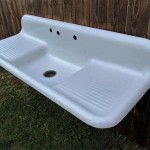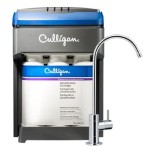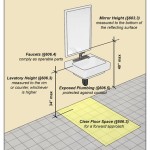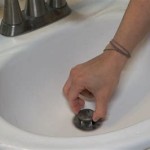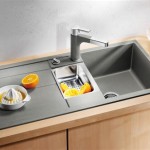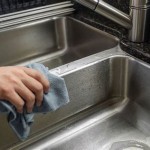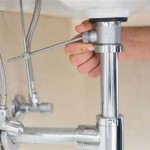How To Clean Your Kitchen Sink Drain
A clogged kitchen sink is a common household nuisance, often caused by a buildup of food particles, grease, and soap residue. Regular cleaning can prevent major blockages and keep the drain flowing freely. This article provides several methods for cleaning a kitchen sink drain, ranging from simple DIY solutions to more involved techniques.
1. Boiling Water
One of the simplest and most effective ways to clear minor clogs is with boiling water. The heat helps melt grease and soap buildup, allowing the debris to flush down the drain. This method is particularly effective for slow-draining sinks caused by grease accumulation.
To use this method, boil a full kettle or pot of water. Slowly pour the boiling water directly down the drain, allowing it to work its way through the blockage. This can be repeated several times if necessary. This is a preventative measure that can be performed weekly or monthly to avoid future clogs. However, it's important to note that boiling water should not be used on porcelain sinks as it can cause cracking.
2. Baking Soda and Vinegar
Another popular and environmentally friendly method involves using baking soda and vinegar. This creates a chemical reaction that helps break down organic matter, effectively clearing clogs. This method is safe for most types of drains.
Begin by pouring one cup of baking soda down the drain. Follow this with one cup of distilled white vinegar. The mixture will fizz as it reacts. Cover the drain with a stopper or plug to contain the reaction within the pipes. Let the mixture sit for at least 30 minutes, or even overnight for more stubborn clogs. Afterward, flush the drain thoroughly with hot water.
3. Salt and Baking Soda
Similar to the baking soda and vinegar method, salt and baking soda can also be used to clear drain clogs. The combination creates an abrasive and alkaline solution that helps break down and dislodge debris. This method is particularly useful for removing stuck food particles.
Pour one cup of baking soda down the drain, followed by one-half cup of salt. Let the mixture sit for at least 30 minutes. Then, pour a kettle of boiling water down the drain to flush the mixture and debris through the pipes. This method is generally safe for all drain types.
4. Plunger
A plunger is a reliable tool for dislodging stubborn clogs. Ensure there is enough standing water in the sink to cover the cup of the plunger. A tight seal is crucial for effective plunging. If necessary, add more water. Place the plunger over the drain opening, ensuring a complete seal. Push and pull the plunger up and down vigorously for several minutes, maintaining the seal. Remove the plunger and check if the water drains freely. Repeat the process if needed.
For double sinks, seal off the other drain opening with a wet cloth or stopper to prevent pressure from escaping. This concentrates the force of the plunger on the clogged drain.
5. Drain Snake
For more persistent clogs, a drain snake (also known as a plumber's snake) can be a highly effective tool. A drain snake is a flexible metal cable that can be inserted into the drain to break up or retrieve the clog. Feed the snake into the drain opening, rotating it as it moves down. When resistance is met, continue rotating the snake to break up or hook the clog. Carefully pull the snake back out, cleaning off any debris. Flush the drain with hot water to clear any remaining particles.
Different types of drain snakes are available, from simple hand-cranked models to motorized versions. Choose the appropriate type based on the severity of the clog.
6. P-Trap Removal
The P-trap is the curved section of pipe located beneath the sink. It's designed to trap debris and prevent sewer gases from entering the home. This area is also a common location for clogs. Removing and cleaning the P-trap can effectively clear stubborn blockages. Before beginning, place a bucket underneath the trap to catch any water or debris.
Most P-traps are secured with slip nuts that can be loosened by hand or with pliers. Carefully loosen the nuts and remove the trap. Clean the trap thoroughly with a brush and hot water, removing any buildup. Once clean, reassemble the P-trap, ensuring the nuts are tightened securely to prevent leaks.
7. Chemical Drain Cleaners
Chemical drain cleaners are a readily available option. However, these cleaners contain harsh chemicals that can be harmful to pipes and the environment. They should be used as a last resort and with caution. Always follow the manufacturer's instructions carefully and ensure proper ventilation. Wear protective gloves and eye protection when handling these chemicals.
While effective at dissolving organic matter, chemical drain cleaners can damage pipes over time. Frequent use should be avoided. They are also not always effective against solid obstructions like hair or hard objects.

How Often Should I Clean My Drains At Home

How To Clean A Smelly Sink Youtube

How To Unclog A Kitchen Sink The Home

How To Unblock A Kitchen Sink 7 Methods Qs

How To Clean A Stinky Sink Drain By Home Repair Tutor Youtube

How To Clean Kitchen Sink Remove Gunk From Deep Inside Drain No More Smells Express Co Uk

Tidy House 101 How To Clean Sink Drain And Cleaning Tips Tricks

6 Ways To Fix Clogged Drains Keep Pipes Flowing Freely Horizon Services

How To Properly Clean A Kitchen Sink Drain Appliances Connection

How To Clear Food From Drain Homeserve Usa
